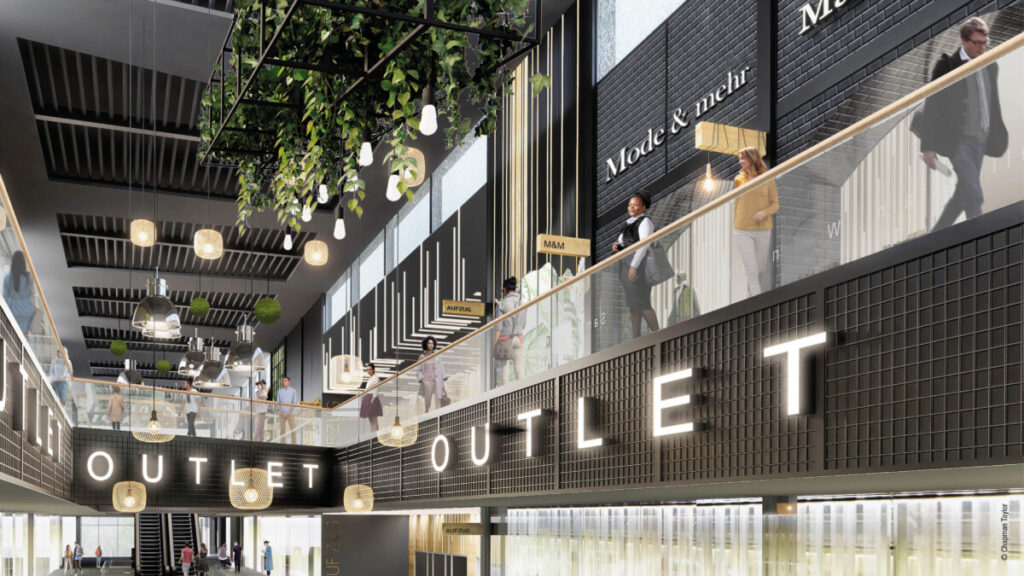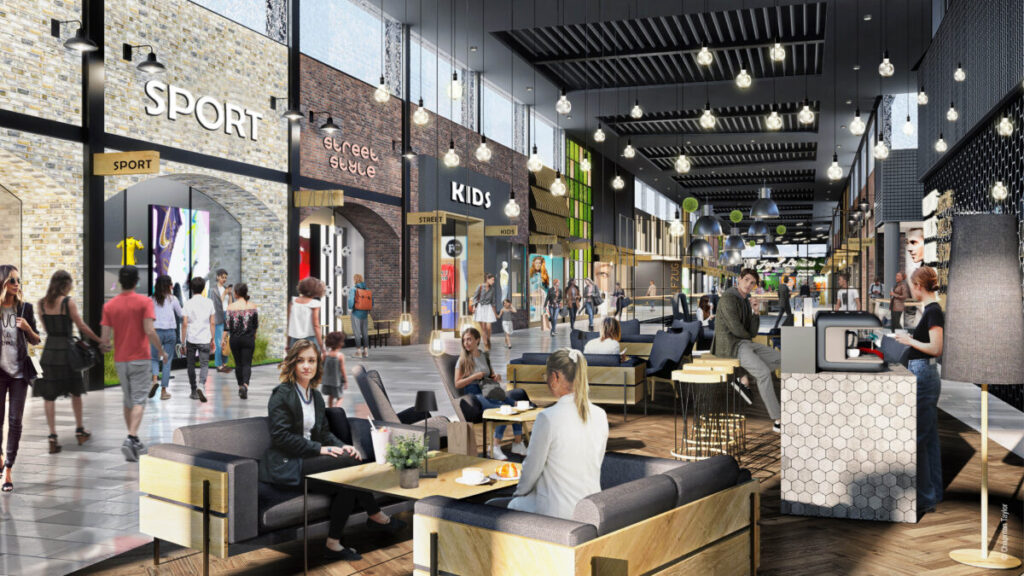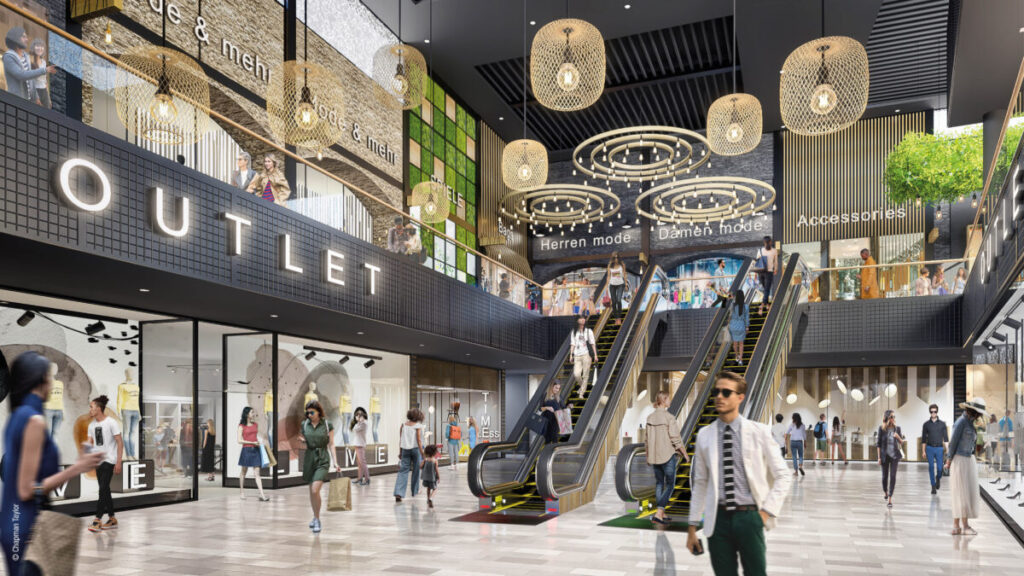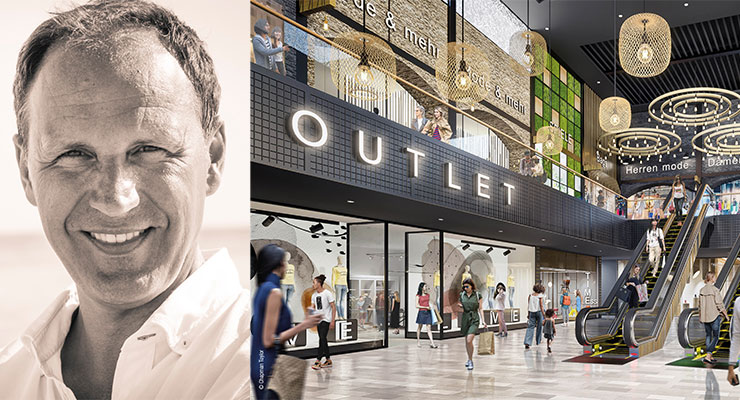ACROSS: You are developing an outlet in an existing shopping center in St. Augustin. This is unusual, even though the industry has long discussed converting shopping centers into outlets. How did this project come about?
MICHAEL HASLINGER: Huma was built back in the 1970s with 20,000 sq m. St. Augustin has no conventional city center; the center has taken over this role. Residential areas surround it and the cities of Cologne and Bonn can be reached in 10–20 minutes. The idea to significantly expand the center was born around 2010. In 2017, the Huma Center opened with 50,000 sq m. In this case, unfortunately, it was bad timing.
ACROSS: In what way?
HASLINGER: The industry was booming in 2010. After the decision to expand, no one could have foreseen how strong online retail would become and how the industry’s growth would decline. Like many locations in Germany, the center struggled with vacancies right from the start. We have 600 shopping centers throughout Germany, 300 of which are too many, in my opinion. The industry’s expansion and development targets were very ambitious for a long time. The aim was to develop two to three shopping centers in each city. During my time at ECE, rental partners were knocking down our doors. Around 2012, the rush had already slowed down, and when Huma opened in 2017, the lower demand had a significant impact. Even then, we were already considering creating a hybrid center. The number of outlets in Germany is very low at 18 locations, given the extensive market, and at the same time, getting approval for a new location is almost impossible.
ACROSS: How did the project gain momentum?
HASLINGER: When the owners, the Jost Hurler Group, approached me, I could confirm the potential for the location. We needed a new branding, not based on a shopping center theme. The result was the main brand, Huma World, with the sub-areas Huma Shopping, Huma Outlet, Huma Gastro, Huma Freshness, and Huma Experience. A large part of the new concept is the outlet on the upper floor of the building. It integrates the themes of gastronomy, which is much more pronounced here than at other outlet locations, and entertainment. Ground and street levels are shopping and freshness, also combined with gastronomy. Shopping complements the outlet area’s brand mix with its range of drugstores, services, telecommunication, and electronics.

ACROSS: How do you explain this concept to customers and rental partners?
HASLINGER: Of course, the customer needs to know that from now on, they will experience something entirely different from what they previously experienced at this location. This is, first and foremost, about visibility. The entire façade structure of the outlet area will stand out from the rest. We have opted for a high-quality architectural style with an industrial feel using wood, stone, and steel and a new atmospheric lighting concept. When customers enter the center at street level, they will immediately see the integrated “Outlet” lettering when they look up. We have developed a uniform concept for the outlet area and the rest of the center. The implementation is certainly a feat of strength that costs a lot of money and is challenging to realize during ongoing operations.
ACROSS: What was your experience: Are the tenants ready for the concept? Up to now, outlet and full-price have always been separated.
HASLINGER: General rules such as that there can only be one outlet store for every ten stores don’t apply any longer. Rental partners have understood that they need outlets, even before the coronavirus pandemic. It is the most vital business with the highest sales at the same or lower costs in terms of staff and rent compared to shopping centers. In addition, we are not in a traditional city center, so there is no direct competition. Furthermore, the established outlet locations in Germany are not growing. Of course, there is always a need to explain new projects. However, the brands’ appetite for outlets is more significant than their skepticism.
ACROSS: Nevertheless, what are the practical implications like when, for example, fullprice and discounted fashion are offered under one roof?
HASLINGER: The big advantage is that we only have four fashion brands left at the location that would go into an outlet. Three of them will soon be leaving due to contractual reasons. What remains is a local fashion store that wants to focus intensely on the premium segment in the future. The opportunity for both sides is that customers can continue the shopping they started in the outlet area. Today, 5.6 million visitors come to the center every year. We are a classic local supplier with shopping and gastronomy components. In the future, we will significantly increase the share of fashion brands with partners who are already popular in the outlet sector. This will attract new customers from 30 to 60 minutes away by car. They aim to find the brands in the outlet for which they are willing to travel further. In addition, they will find a much better and more extensive range of restaurants, can do their everyday shopping, go to Saturn or Telekom, or have their nails done.


ACROSS: How does the outlet benefit from the shopping center?
HASLINGER: Huma Outlet has a clear head start. It already has existing customers. Huma Outlet is be opening with 5.6 million customers. There are also first-class transport links for public transport, cars, and pedestrians. There was no need for any conversion work. This makes us particularly attractive to the customer group under 18, who would otherwise not come to the other outlets on their own. Another major advantage, as already mentioned, is the significantly stronger gastronomy, which we will continue to promote and expand. This is an excellent advantage for the length of stay. We are creating a food court on the upper floor with seven stores, an outdoor terrace, lounge areas, and a coffee bar. This creates an atmosphere that no other outlet can offer. For economic reasons alone, no other location will do this, as a store lease is always more attractive for the owner than a restaurant lease.
ACROSS: How do you deal with store sizes? These differ greatly between shopping centers and outlets.
HASLINGER: The ideal space size in the outlet is between 150 and 180 sq m. We have drawn up a strategic plan to divide or combine each space in such a way as to create the optimum space to satisfy most of our tenants. We currently have a 60 percent vacancy on the top floor. Furthermore, we are gradually shifting the 40 percent vacancy to the lower floors. However, the rental space downstairs is not always tailored to the tenant’s needs. An example: a shoe retailer takes over the space of a toy retailer, who in turn moves into a space that still needs to be converted for him. The space for the shoe retailer has to be enlarged, but the neighboring tenant has to be relocated. So, we must wait until the first tenant has completed the move before the next step can begin. Only then can all retailers move. The challenge lies not in finding the right space size but in coordinating the timeline during ongoing operations while complying with all requirements.
ACROSS: A significant difference between shopping centers and outlets lies in the structure of the lease agreements. Does a hybrid center mean that the contracts in the shopping center section are more closely aligned with the outlet contracts and, therefore, focus more on turnover rents and tenant-landlord cooperation?
HASLINGER: No, there is still a separation. The brands in the outlet have a classic outlet lease, which runs for five to ten years and is based heavily on the turnover rent in addition to the basic rent. The brands in the shopping center area, such as Telekom or Müller, have never been in the outlet. Attempts have been made occasionally in other places to realize an outlet lease in classic shopping centers. This attempt was clearly rejected. These are two different worlds in this respect.
ACROSS: Another point in which outlets and shopping centers differ is the marketing budget, which is generally higher in the outlet.
HASLINGER: Here, too, the two sectors remain in separate worlds. The marketing of the shopping center is aimed at the local retail sector. My company is responsible for the entire outlet management, focusing on retail and marketing. The outlet has a high six-figure sum per year at its disposal. We use this to attract customers who are a 30 to 60-minute drive away, who come to the outlet on average four times a year. All other brands benefit from this. Of course, the marketing concept is coordinated with IPH, which operates the shopping center. For example, latenight shopping is impossible if the rest of the center does not participate.
ACROSS: It is often said that shopping centers can learn a lot from outlets. How does this learning effect work when shopping centers and outlets are neighbors?
HASLINGER: I think we should not forget that shopping centers and outlets are two different concepts. An outlet is defined by its brands. People come primarily because of certain brands. A good example is the Designer Outlet Roermond in the Netherlands. Nowhere else in Europe will customers find such a concentration of brands as here. This is impossible in a shopping center, as it is primarily a local supplier. The reason to go there is quite different. In addition, 70–80 percent of outlets consist of fashion brands, offering different margins. A visit to an outlet is usually a planned event for the customer, unlike a trip to a nearby shopping center.
ACROSS: Finally, the question arises: Is this a recipe for other faltering shopping centers with high vacancy rates?
HASLINGER: No, the project is only possible because the location in St. Augustin is so unique. The vast majority of shopping centers in Germany are located in city centers. You can’t develop an outlet in a city center because there is too much competition from other providers. Outlets need a certain distance from the full-price segment. In addition, shopping centers are generally not built in such a way that outlet spaces can be created in them. I can think of perhaps 3–4 centers in Germany that can potentially become hybrid centers. Another point that is more geared towards implementation is that we work with a single owner in St. Augustin. We can, therefore, make decisions in real-time. This is a huge advantage for such a complex project.
ACROSS: This means that the location’s further development depends on the outlet`s success. Will Huma`s outlet share increase in the future?
HASLINGER: Dynamic retail will show where this leads. I assume that a fashion brand that wants to come to Huma will always prefer the outlet, except brands that don’t do outlets, such as Inditex or H&M. In the end, this is a question that the owner has to ask himself and whether he will allocate the space to the outlet in the future.
Project Overview HUMA WORLD:
Location: Sankt Augustin Zentrum, Germany;region Cologne-Bonn
Catchment Area:
- 2 million inhabitants up to 30 minutes by car
- 6,7 million inhabitants up to 60 minutes by car
- 14 million inhabitants, up to 90 minutes by car
HUMA WORLD: 50,000 sq m; 130 shops
HUMA OUTLET: 9,000 sq m; 40 shops
Tourism: 6 million tourists per year (2019)
Opening: estimated for autumn 2024

Michael Haslinger
Michael Haslinger learned the shopping center and outlet business from the ground up. He began his career with major retail brands such as Spar, Aldi, and Kaufland before working for ECE for a good eight years, in particular as Head of the Leasing Department in Romania. He then dedicated himself to the outlet sector and worked for McArthurGlen for a long time, including three years as Leasing Director for Northern Europe. In 2012, he ventured into self-employment and founded “Haslinger Retail Real Estate Consulting” shortly afterward.
HASLINGER RETAIL REAL ESTATE CONSULTING: The company’s strength lies in developing a wide variety of outlet concepts, from city outlets to specialist retail outlets, in line with demand and in a sustainable manner. It not only handles the letting but also the subsequent management. “Haslinger Retail Real Estate Consulting” is working on 15 projects in four countries, including the Outlet Village in Sofia, Bulgaria, the Outlet City Weil am Rhein, Germany, and the City Outlet Bad Münstereifel, Germany.






